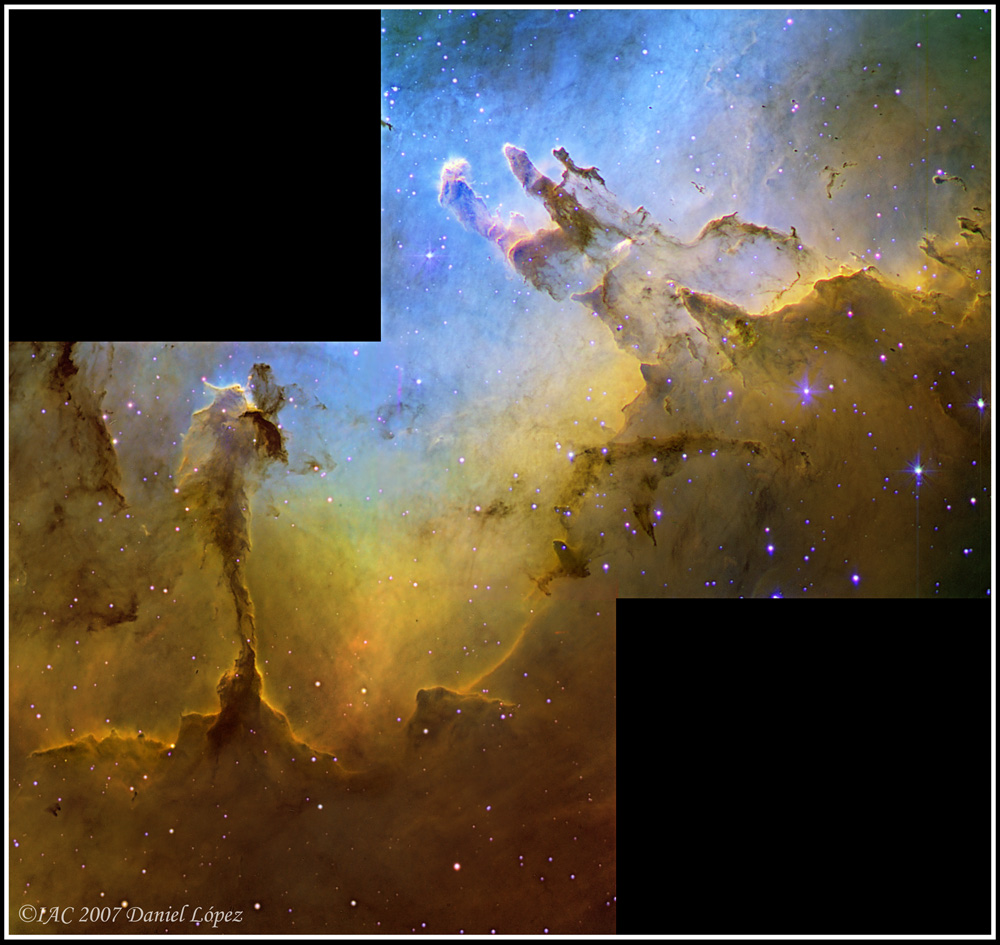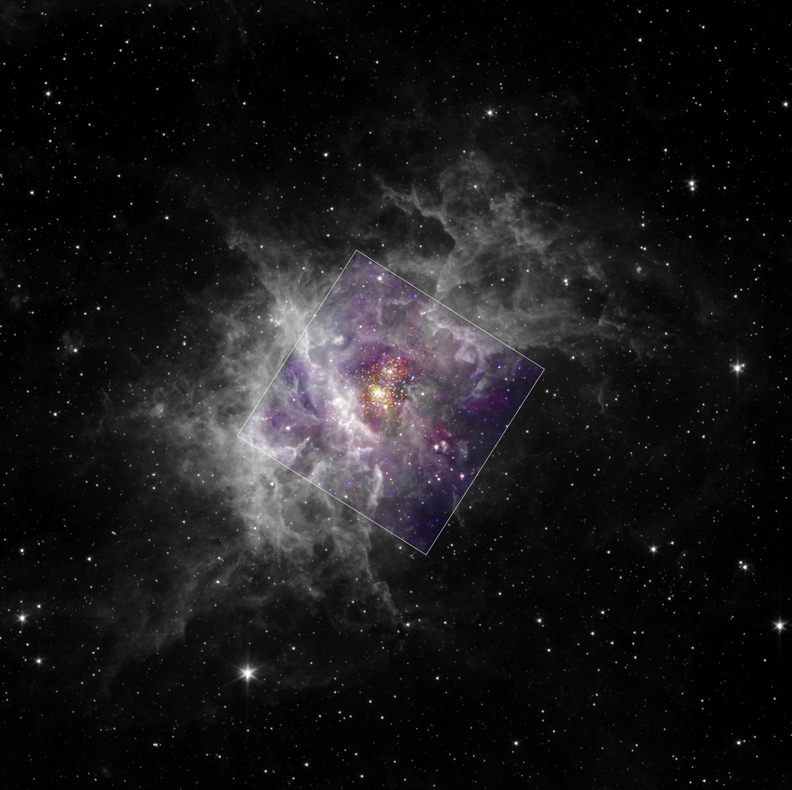 The pillars of the Eagle Nebula, bright stars are still forming in this well-known image taken by the Hubble Space Telescope in 1995. The light taken in was emitted only from Hydrogen, Sulfur, and Silicon, contributing to the high resolution of this image. These bright stars have been continually forming for nearly 5 million years. The nebula, also known as M16, spans nearly 20 light-years and can be viewed near the constellation Serpens.
The pillars of the Eagle Nebula, bright stars are still forming in this well-known image taken by the Hubble Space Telescope in 1995. The light taken in was emitted only from Hydrogen, Sulfur, and Silicon, contributing to the high resolution of this image. These bright stars have been continually forming for nearly 5 million years. The nebula, also known as M16, spans nearly 20 light-years and can be viewed near the constellation Serpens.Friday, February 29, 2008
3.13 The Eagle Nebula
 The pillars of the Eagle Nebula, bright stars are still forming in this well-known image taken by the Hubble Space Telescope in 1995. The light taken in was emitted only from Hydrogen, Sulfur, and Silicon, contributing to the high resolution of this image. These bright stars have been continually forming for nearly 5 million years. The nebula, also known as M16, spans nearly 20 light-years and can be viewed near the constellation Serpens.
The pillars of the Eagle Nebula, bright stars are still forming in this well-known image taken by the Hubble Space Telescope in 1995. The light taken in was emitted only from Hydrogen, Sulfur, and Silicon, contributing to the high resolution of this image. These bright stars have been continually forming for nearly 5 million years. The nebula, also known as M16, spans nearly 20 light-years and can be viewed near the constellation Serpens.Thursday, February 28, 2008
3.11 Pickering Biography Sources
Works Cited
Bailey, Solon I. The History and Work of Harvard Observatory, 1839 to 1927. New York: McGraw-Hill, 1931. Internet Archive. 28 Feb. 2008 [http://www.openlibrary.org/details/historyandworkof031439mbp].
Plotkin, Howard. "Edward C. Pickering and the Endowment of Scientific Research in America, 1877-1918." Isis 69 (1978): 44-57. JSTOR. 28 Feb. 2008 [http://links.jstor.org/sici?sici=0021- 1753%28197803%2969%3A1%3C44%3AECPATE%3E2.0.CO%3B2-8].
Tenn, Joseph S. "Edward Charles Pickering." The Bruce Medalists. 11 Feb. 2006. Sonoma State University. 28 Feb. 2008 [http://www.phys-astro.sonoma.edu/BruceMedalists/Pickering/index. html].
3.9 Young Stars in the Rho Ophiuchi Cloud
 Taken by the Spitzer Space Telescope, this image shows cosmic dust clouds and embedded newborn stars in false color. This image is part of the Rho Ophiuchi cloud complex some 400 light-years away, one of the closest star forming regions to Earth. The large cloud of cool Hydrogen is heated by these new stars, causing it to glow in the infrared. This image spans about 5 light-years.
Taken by the Spitzer Space Telescope, this image shows cosmic dust clouds and embedded newborn stars in false color. This image is part of the Rho Ophiuchi cloud complex some 400 light-years away, one of the closest star forming regions to Earth. The large cloud of cool Hydrogen is heated by these new stars, causing it to glow in the infrared. This image spans about 5 light-years.
Wednesday, February 13, 2008
3.8 Apparent Magnitude Worksheet
Apparent Magnitude Worksheet
- Eta Aurigae 3.5
- Beta Eridani 3.9
- Gamma Orionis 2.4
- Beta Tauri 3.1
- Delta Orionis 2.1
- Zeta Orionis 2.0
- Mu Geminorum 2.8
- Xi Geminorum 3.7
- Sigma Canis Majorum 4.4
- Eta Canis Majorum 1.9
- Alpha Geminorum (Castor) 1.0
Thursday, February 7, 2008
3.7 Light Echoes fro V838 Mon
 For unknown reasons, the star V838 Mon brightly expanded, making it the greatest star in the Milky Way in 2002, suddenly fading soon after. In this stellar flash, supernovas and novas appeared to expel matter into the universe. However, what actually happened is that this matter formed an outwardly moving "light echo." In a light echo, light from the flash is reflected by successively more distant rings of interstellar dust that already surrounded the star. V8383 Mon is about 20,000 light-years away in the constellation Monoceros.
For unknown reasons, the star V838 Mon brightly expanded, making it the greatest star in the Milky Way in 2002, suddenly fading soon after. In this stellar flash, supernovas and novas appeared to expel matter into the universe. However, what actually happened is that this matter formed an outwardly moving "light echo." In a light echo, light from the flash is reflected by successively more distant rings of interstellar dust that already surrounded the star. V8383 Mon is about 20,000 light-years away in the constellation Monoceros.
Saturday, February 2, 2008
3.6 Observation Log
Date: February 01, 2008
Time: 7:30-9:30
Location: 270 15' 29.35" N, 820 23' 44.36" W; My Home
Sky Conditions: Very clear and great visibility. Considerable light pollution in NW (from Sarasota)
Instruments: None
Planets: Mars
Bright Stars Noted: Sirius, Rigel, Betelgeuse, Pollux, Castor, Capella, Aldebaran, Achernar, Algol, Arneb, Procyon
Constellations Noted: Lepus, Columba, Canis Major, Gemini, Orion, Monoceros, Eridanus (I only traced part of it as I lost sight of the rest), Taurus, Perseus, Cassiopeia, Camelopardalis (only two stars visible), Aries, Auriga, Canis Minor
Binary Stars: Rigel, Capella, Algol (However, could not distinguish separate stars as no instruments were used)
Deep Sky Objects: Hyades, Pleiades
Asterisms: The Three Kids (Auriga), Orion's Belt & Orion's Sword (Orion), The Worm (Cassiopeia)
Time: 7:30-9:30
Location: 270 15' 29.35" N, 820 23' 44.36" W; My Home
Sky Conditions: Very clear and great visibility. Considerable light pollution in NW (from Sarasota)
Instruments: None
Planets: Mars
Bright Stars Noted: Sirius, Rigel, Betelgeuse, Pollux, Castor, Capella, Aldebaran, Achernar, Algol, Arneb, Procyon
Constellations Noted: Lepus, Columba, Canis Major, Gemini, Orion, Monoceros, Eridanus (I only traced part of it as I lost sight of the rest), Taurus, Perseus, Cassiopeia, Camelopardalis (only two stars visible), Aries, Auriga, Canis Minor
Binary Stars: Rigel, Capella, Algol (However, could not distinguish separate stars as no instruments were used)
Deep Sky Objects: Hyades, Pleiades
Asterisms: The Three Kids (Auriga), Orion's Belt & Orion's Sword (Orion), The Worm (Cassiopeia)
Friday, February 1, 2008
3.5 Young Star Cluster in Westerlund 2

Star forming region RCW 49 surrounds a young star cluster, Westerlund 2. This cluster is not able to be seen in the visible spectrum, so this image was captured in the infrared by the Spitzer Space Telescope. The black and white image is from the infrared data. The color image was taken with X-ray from the Chandra telescope, appearing in false color. Westerlund 2 is in Centaurus. This cluster contains some of our galaxy's most luminous and massive stars and is 2 million years old or less.
Subscribe to:
Posts (Atom)



